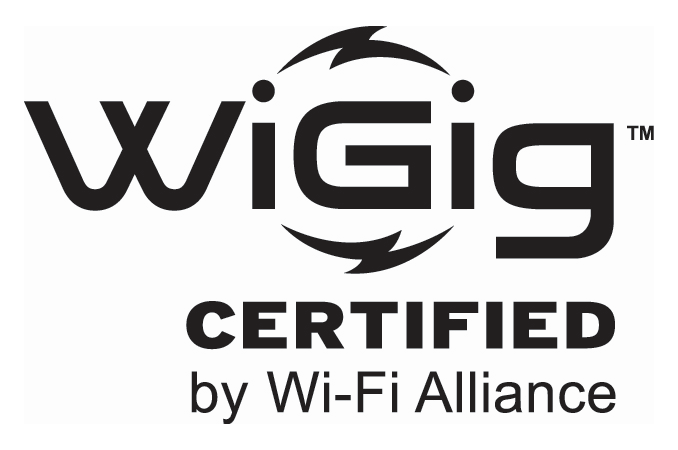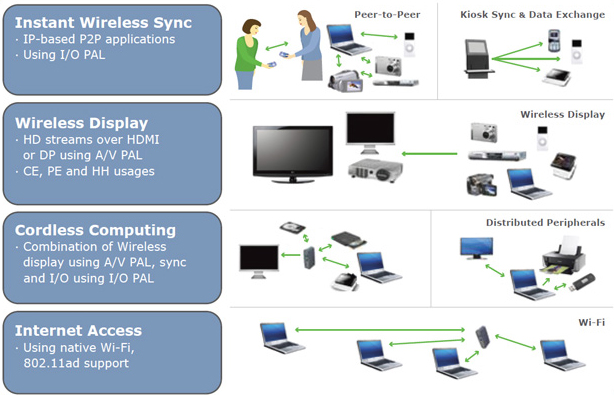Wi-Fi Alliance Begins to Certify 802.11ad WiGig Devices
by Anton Shilov on October 28, 2016 9:00 PM EST- Posted in
- Smartphones
- 802.11ad
- WiGig
- Wi-Fi
- Notebooks
- 60 GHz
- Wi-Fi Alliance

The Wi-Fi Alliance this week began to certify products featuring wireless modules compatible with the 802.11ad standard (aka WiGig). The certification will help to ensure that all WiGig-branded devices, which have been around for some time, can flawlessly operate with each other and deliver expected multi-gigabit performance over 60 GHz spectrum.
The WiGig technology (IEEE 802.11ad) is a short range communication standard that enables compatible devices to communicate at up to 7–8 Gb/s data rates and with minimal latencies, using the 60 GHz spectrum at distances of up to ten meters. Since 60 GHz signals cannot penetrate walls, the technology can be used to connect devices that are in direct line of sight. Given the limitation, WiGig cannot replace Wi-Fi or even Bluetooth, but it can enable devices like wireless docking stations, wireless AR/VR head-mounted displays, wireless high-performance storage devices, wireless displays, and others devices which need a lot of bandwidth.
To date, Intel and Qualcomm have released several tri-band chipsets that support the 2.4 GHz, 5 GHz and 60 GHz spectrums as well as Wi-Fi, Bluetooth and WiGig technologies. The Wi-Fi Alliance has already certified Intel’s Tri-Band Wireless 18260 (Maple Peak) and Qualcomm’s QCA9500 802.11ad-compatible chipsets as well as multiple devices that use them (including Dell’s Latitude E7450/70 as well as 802.11ad 60 GHz USB adapters from Peraso and Socionext). Going forward, the organization will certify other products, including smartphones and docking stations.
It should be noted that the start of WiGig certification on its own isn't going to be the catalyst to cause WiGig adoption to take off, but it will increase chipset developers', device makers', and end users' confidence in the standard. Designers of Wi-Fi chipsets and manufacturers of actual systems have been reluctant to adopt 802.11ad so far because the infrastructure is absent and so is demand, a classic chicken and egg dilemma. With the official certification process things will likely get a little better, mainly because of added confidence.
Meanwhile, analysts from ABI Research believe that 180 million of WiGig-enabled chipsets will ship inside smartphones already next year with 1.5 billion WiGig devices shipping in 2021.
Image Source: Blu Wireless Technology.
Source: Wi-Fi Alliance












50 Comments
View All Comments
supdawgwtfd - Friday, October 28, 2016 - link
Point being? Its a phone. It can't make use of all the bandwidth.lilmoe - Saturday, October 29, 2016 - link
It can benefit a lot. Screen mirroring, for starters, can use all the bandwidth it can get. I don't mind a solution where i can use my smartphone to stream high quality video from back camera directly to my laptop. The possibilities are endless, it's not only about storage.prisonerX - Saturday, October 29, 2016 - link
"wireless docking stations, wireless AR/VR head-mounted displays, wireless high-performance storage devices, wireless displays"Seriously, every single one of the uses mentioned in the article applies to phones, and the greater the bandwidth the faster transfers happen.
prisonerX - Saturday, October 29, 2016 - link
640K should be enough for anyone.damianrobertjones - Saturday, October 29, 2016 - link
One day you might read the rest of that comment and realise what he meant.BrokenCrayons - Monday, October 31, 2016 - link
Bill Gates has said multiple times that he's never said that line.http://www.computerworld.com/article/2534312/opera...
mkozakewich - Monday, October 31, 2016 - link
I'll bet someone was like, "640K? Is that enough for me to do my quaint 80s work?" and he probably said something like, "Oh, yeah, 640K ought to be enough."jtgmerk - Sunday, October 30, 2016 - link
they said that about 640k ram as well and people were stupid for installing 1mb ram modules.Mr_Bird_Man - Sunday, October 30, 2016 - link
Yeah, but with that extra 384k you could create a RAM drive which command.com and other key OS components could be copied over to upon bootup. You could also use some of it as a HD cache, so no, 1MB wasn't bad if you used it properly.mkozakewich - Monday, October 31, 2016 - link
No, those were 1MB modules. The graphics adapter used the memory from 640K onwards, but there were tricks to get around some of that. So it was 640K available memory, even with 1MB modules.